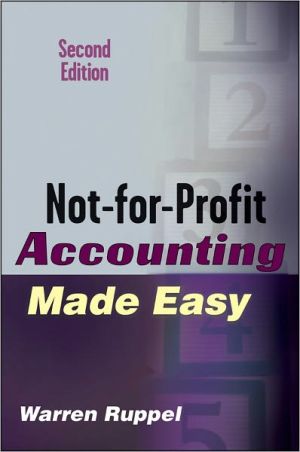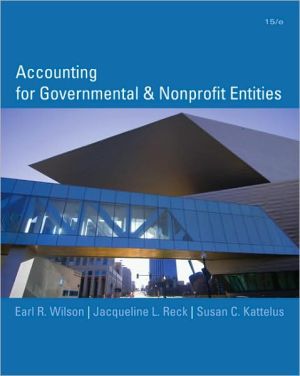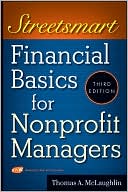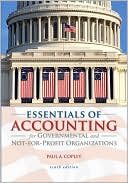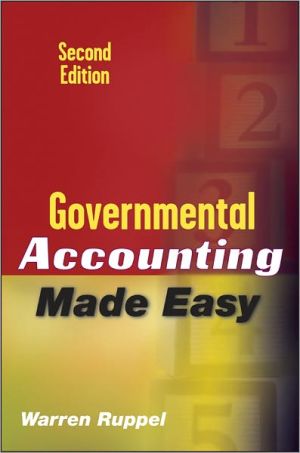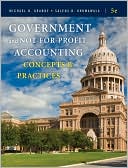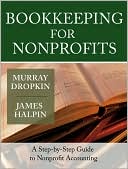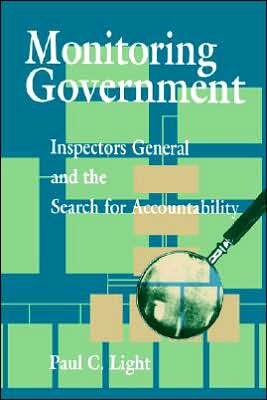Not-for-Profit Accounting Made Easy
A hands-on guide to the ins and outs of nonprofit accounting\ Not-for-Profit Accounting Made Easy, Second Edition equips you with the tools you need to run the financial and accounting operations within your nonprofit organization. Even if you do not have a professional understanding of accounting principles and financial reporting, this handy guide makes it all clear with complex accounting rules explained in terms nonaccountants can easily understand in order to help you better fulfill your...
Search in google:
Not-for-ProfitAccounting Made EasySecond EditionThe world of accounting can be intimidating but there's no way to avoid it—even nonprofit organizations must venture into financialjargon and concepts. Now in a second edition, Not-for-Profit Accounting Made Easy, Second Edition shows you how to read and understand a nonprofit financial statement, while providing you with a basic understanding of the accounting and financial reporting practices of a nonprofit.Clarifying nonprofit accounting principles and reporting standards in simple terms that are easily understood by those with little or no prior accounting experience, Nonprofit Accounting Made Easy, Second Edition conforms to FASB and AICPA standards and forms and introduces you to:Basic accounting terminologyFundamental accounting conceptsBasic financial statements of a nonprofit organizationAccounting for contributions, investments and financial instruments, activities with joint costs, affiliated organizations, and collectionsAccounting peculiarities of health care, education, and religious and cultural nonprofitsAccounting for leasesAccounting for pension plans and other employee benefit plansSimple and practical in approach, this book is helpful not only for nonaccountants with accounting duties but also for people who work with nonprofits in a variety of capacities. Since nonprofit accounting differs in many subtle ways from normal business accounting, this book shows you how to brush up on the idiosyncrasies that separate the two. Management and staff, board members, consultants, donors, and creditors can all benefit from understanding the fundamental principles of nonprofit accounting. With updated GAAP hierarchy discussions including the PCAOB and its impact on standards setting and applicability to nonprofit organizations, Nonprofit Accounting Made Easy, Second Edition offers a wealth of practical information on putting accounting principles to work for your nonprofit. Booknews In this volume, a CPA explains not-for-profit accounting principles and reporting standards in simple terms that may be understood by those with little or no prior accounting experience. Conforms with FASB and AICPA standards and forms. Suitable for not-for-profit management, staff, board members, consultants, donors, creditors, and professional accountants. Annotation c. Book News, Inc., Portland, OR (booknews.com)
Not-for-Profit Accounting Made Easy\ \ By Warren Ruppel \ John Wiley & Sons\ ISBN: 0-471-20679-2 \ \ \ Chapter One\ Understanding the Basics of Not-for-Profit Accounting \ This chapter provides some very basic information about not-for-profit accounting to provide a basis for understanding the principles and standards that are discussed in greater detail throughout the remainder of this book. A lack of understanding or misunderstanding of these fundamentals will cause the reader to be lost when trying to understand more complex principles. Specifically, this chapter will:\ Identify generally accepted accounting principles.\ Define and give examples of assets, liabilities, net assets, revenues, and expenses usually found in not-for-profit organizations' financial statements.\ Explain what is meant by the accrual basis of accounting. How does this differ from the cash basis of accounting, and which is better?\ Describe what happened to fund accounting.\ WHAT ARE GENERALLY ACCEPTED ACCOUNTING PRINCIPLES?\ Non-accountants sometimes ask the question, "Well, if these accounting principles are only generally accepted, that must mean that there are other perfectly good accounting principles that have less than general acceptance that are fine to use." Unfortunately for those desiring creativity and uniqueness in their accounting principles, this is not the case. Generally accepted accounting principles (GAAP) are the rules of road that need to be followed by not-for-profitorganizations if they want to proclaim that their financial statements are prepared in accordance with GAAP.\ WHY IS PREPARING GAAP FINANCIAL STATEMENTS IMPORTANT?\ Sometimes not-for-profit organizations are required by law or regulation to prepare financial statements in accordance with GAAP. Most states require that not-for-profit organizations that are organized within a state (or raise funds within that state) file an annual report with the state charities bureau (or its equivalent) and, for all but the smallest not-for-profit organizations, the annual reports usually require that financial statements prepared in accordance with GAAP be included with the annual report.\ Several other groups are also fond of financial statements prepared in accordance with GAAP. Large, sophisticated donors often request copies of an organization's financial statements, and having these financial statements prepared in accordance with GAAP lends a high degree of credibility to the financial statements. Creditors that loan money or provide credit lines to not-for-profit organizations also like to see GAAP financial statements. Sometimes a significant vendor or contractor will also request financial statements of the organization, particularly when a long-term lease or equipment-financing contract is being executed. Having financial statements prepared in accordance with GAAP makes them more understandable, comparable with other not-for-profit organizations, and provides a better representation of the financial affairs of the not-for-profit organization. Additionally, if the not-for-profit organization provides services to a governmental organization (federal, state, city, school district, county, etc.), the contract with the governmental entity often requires that financial statements prepared in accordance with GAAP be submitted to the government every year.\ Who Sets the Laws of GAAP?\ Generally accepted accounting principles for not-for-profit organizations are basically set by the Financial Accounting Standards Board (FASB). The FASB is a private organization that is financially controlled and supported by the Financial Accounting Foundation (FAF), itself a not-for-profit organization. The FAF also oversees the Governmental Accounting Standards Board (GASB), which sets GAAP for governmental entities.\ The first level in the GAAP hierarchy, category A, consists of Financial Accounting Standards Board (FASB) Statements of Financial Accounting Standards and Interpretations (as an example, the reader may be familiar with FASB Statement No. 117, which has had a significant impact on financial reporting for not-for-profit organizations and will be discussed throughout this book). Also at the highest level of authority are statements issued by the FASB's predecessor standards-setting organizations, opinions issued by the now-defunct Accounting Principles Board (APB), and Accounting Research Bulletins, which were formerly issued by the American Institute of Certified Public Accountants (AICPA).\ The next level in the GAAP hierarchy, category B, consists of FASB Technical Bulletins and, if cleared by the FASB, Industry Audit and Accounting Guides issued by the AICPA and Statements of Position issued by the AICPA.\ The third category, category C, consists of AICPA Accounting Standards Executive Committee Practice Bulletins that have been cleared by the FASB and issues resolved by the FASB's Emerging Issues Task Force.\ The lowest level in the GAAP hierarchy, category D, consists of AICPA Accounting Interpretations and Implementation Guides published by the FASB staff. Also included in this category are other practices that are widely recognized as prevalent, either generally or as pertain to a specific industry.\ While these terms may not mean much to the non-accountant, it is important for the reader to at least be a little familiar with them in order to have an idea of their relative importance, which can come in handy in conversations with a not-for-profit organization's accountants or independent auditors.\ Who Makes Sure the Not-for-Profit Organization's Financial Statements Conform with GAAP?\ The answer may surprise the non-accountant, but the fair presentation of a not-for-profit organization's financial condition and results of operations in its financial statements prepared in accordance with GAAP is the responsibility of the not-for-profit organization's management. For those who would have guessed this responsibility was that of the not-for-profit organization's independent auditor, a serious change in paradigm needs to be made. Independent auditors are hired to perform an audit and issue an opinion as to whether the financial statements prepared by management are presented in accordance with GAAP. Not-for-profit organizations are notorious for passing the responsibility for preparing financial statements off to the independent auditor. The common reason for doing this, particularly in smaller organizations, is that the not-for-profit organization may not have individuals with the technical expertise on staff to take full responsibility for preparing the financial statements. While it is understandable how this happens, the management of the organization is, in fact, responsible for the financial statements. If assistance is needed of the independent auditor, management should at least understand how the financial statements are ultimately prepared and what types of adjustments to the organization's books and records are being made by the independent auditor to result in GAAP financial statements.\ It is worth noting, however, that independent auditors take the fact that the financial statements are management's responsibility very seriously. The second sentence of a standard auditor's opinion letter states: "These financial statements are the responsibility of XYZ's management." While this is most assuredly an attempt by independent auditors to limit their legal exposure in case the financial statements actually are not prepared in accordance with GAAP, it does highlight the fact that, the way the system works, the financial statements are management's responsibility.\ What Happens If the Financial Statements Are Not in Accordance with GAAP?\ It depends. If a not-for-profit organization prepares financial statements that its management believes are in accordance with GAAP while its independent auditor does not believe they are in accordance with GAAP, one of two things can happen:\ The not-for-profit organization accepts changes to the statements prepared by the auditor and corrects the financial statements. In this case, both management and the independent auditor now believe the financial statements are prepared in accordance with GAAP. The problem is resolved and the independent auditor issues an unqualified opinion on the financial statements.\ The not-for-profit organization may disagree with the changes proposed by the auditor. On the other hand, the independent auditor may propose that an adjustment be made to the financial statements or that additional disclosures be included, but the management of the not-for-profit organization is unable to obtain the necessary information with which to adjust the financial statements. In this case, the auditor will issue a qualified opinion on the financial statements because of the departure from GAAP. This means that the financial statements are prepared in accordance with GAAP, with the exception of the problem item. In some rare cases, if the problem is so serious that it is pervasive and affects the financial statements as a whole, the auditor may issue an adverse opinion on the financial statements. This means that the financial statements in their entirety are not prepared in accordance with GAAP.\ The acceptance of financial statements that are not in accordance with GAAP will vary among the different users of those financial statements. A state charities office may accept financial statements that are qualified for a GAAP exception, but may not accept statements with an adverse opinion. A bank or other creditor may find that any departure from GAAP in a not-for-profit organization's financial statements would be a negative factor in determining whether credit should be granted to the not-for-profit organization.\ Tip A not-for-profit organization may deliberately choose not to use GAAP for its financial statements, but rather an "other comprehensive basis of accounting" (OCBA), such as the cash basis, for the statements. More on this topic will be provided later in this chapter.\ The bottom line of this discussion is that GAAP is widely recognized as providing the best information about a not-for-profit organization's financial position and activities. For all but the smallest not-for-profit organizations (which may not even issue financial statements), it is likely that the benefits of having financial statements prepared in accordance with GAAP will outweigh the costs.\ Red Flag Not-for-profit organizations often prepare annual financial statements on a GAAP basis, while providing their board of directors or executive management with financial information on a quarterly basis. The total of all four quarters of these quarterly financial information reports often does not equal amounts reported in financial statements prepared in accordance with GAAP, because there are frequently adjustments made to conform to GAAP that are only made when the annual financial statements are prepared. Common examples include depreciation expense, bad debt expense, and inventories (each of which will be discussed later in greater detail), which are only recorded annually and not reflected in quarterly financial information.\ DEFINITIONS AND EXAMPLES OF ASSETS, LIABILITIES, REVENUES, AND EXPENSES USUALLY FOUND IN NOT-FOR-PROFIT ORGANIZATIONS' FINANCIAL STATEMENTS\ In order to understand the basic financial statements of a not-for-profit organization and how various transactions are accounted for under GAAP, the reader needs to understand the various asset, liability, revenue, and expense accounts typically found in the financial statements of not-for-profit organizations. Some accounts are easier to describe (for example, cash) than others (for example, deferred charges). Even with the easier accounts, there are often underlying rules that need to be understood to really comprehend the financial statement item being reported. Using the example of cash, the financial statement reader might be interested in knowing the distinctions between unrestricted cash and restricted cash and how each is reported. The financial statement reader might also be interested in knowing what cash equivalents are, which are sometimes included in the financial statement line item Cash and cash equivalents. The point is that there are any number of nuances and requirements that have developed that determine how items are reported. The following pages describe some of the more common items encountered in not-for-profit financial accounting. (Again, note that this discussion provides only basic rules. Financial statement preparers need to refer to the comprehensive rules found in other sources, such as Wiley's Not-for-Profit GAAP, which is written for those requiring a more in-depth understanding of the GAAP requirements.)\ Assets\ Let us start by looking at the GAAP definition of an asset. FASB Concepts Statement No. 6, "Elements of Financial Statements" (FASBCS 6), defines assets in the following way: "Assets are probable future economic benefits obtained or controlled by a particular entity as a result of past transactions or events." And all this time you thought that assets were stuff that you owned! The fact is, the FASB definition is meant to provide a broader context to assets, rather than a narrower definition that only implies ownership. For example, if a not-for-profit organization prepays its liability insurance premium for the following year, it really does not "own" anything as a result of that prepayment. However, the prepayment will provide a future economic benefit to the not-for-profit organization, which will be insured during the following year without having to pay an insurance premium in that year. Thinking of assets as including things that the organization owns as well as future economic benefits that it is entitled to will help the reader understand what types of items are considered assets.\ Note also that assets are measured in financial statements as of a point in time, that is, as of the date of the statement of financial position, which is sometimes referred to as the balance sheet. For example, if the not-for-profit organization's fiscal year-end is June 30, its statement of financial position will report its assets as of that date. Assets are also presented in the statement of financial position in their order of liquidity, which means the assets that can be converted the most readily into cash are reported first. More information on this concept will be presented in Chapter 2.\ \ Continues...\ \ \ \ Excerpted from Not-for-Profit Accounting Made Easy by Warren Ruppel Excerpted by permission.\ All rights reserved. No part of this excerpt may be reproduced or reprinted without permission in writing from the publisher.\ Excerpts are provided by Dial-A-Book Inc. solely for the personal use of visitors to this web site. \ \
Preface.Chapter 1: Understanding the Basics of Not-for-Profit Accounting.Chapter 2: Basic Financial Statements of a Not-for-Profit Organization.Chapter 3: Accounting for Contributions.Chapter 4: Accounting for Investments and Financial Instruments.Chapter 5: Accounting for Activities with Joint Costs and Indirect Cost Allocation.Chapter 6: Affiliated Organizations.Chapter 7: Collections.Chapter 8: Split-Interest Agreements.Chapter 9: Accounting for Pension and Other Postretirement Employee Benefit Plans.Chapter 10: Lease Accounting Fundamentals.Chapter 11: Analyzing the Financial Health of Not-for-Profit Organizations.Chapter 12: Current Developments in Not-for-Profit GAAP.Index.
\ BooknewsIn this volume, a CPA explains not-for-profit accounting principles and reporting standards in simple terms that may be understood by those with little or no prior accounting experience. Conforms with FASB and AICPA standards and forms. Suitable for not-for-profit management, staff, board members, consultants, donors, creditors, and professional accountants. Annotation c. Book News, Inc., Portland, OR (booknews.com)\ \
